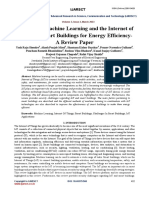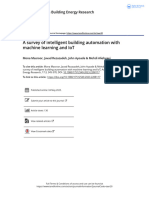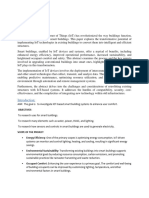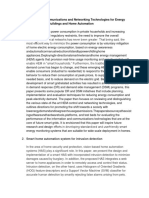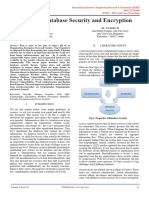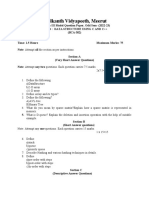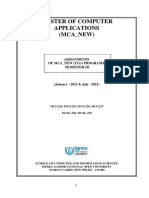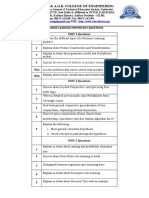LIST OF PUBLICATIONS
JOURNALS
• Singh, T., Solanki, A., Sharma, S. K., Nayyar, A., & Paul, A. (2022) A Decade
Review on Smart Cities: Paradigms, Challenges and Opportunities. IEEE Access,
Impact factor: 3.9, DOI: 10.1109/ACCESS.2022.3184710.
• Singh, T., Solanki, A., Sharma, S. K., Jhanjhi, N. Z., & Ghoniem, R. M. (2023) Grey
Wolf Optimization Based CNN-LSTM Network for the Prediction of Energy
Consumption in Smart Home Environment. IEEE Access, Impact factor: 3.9,
DOI: 10.1109/ACCESS.2023.3311751.
• Tarana Singh, Arun Solanki, Sanjay Kumar Sharma, (2024) A Novel
Recommendation System Based on IAP And SGKRU for Energy Management in
Smart Homes. Communicated in Computers and Electrical Engineering, Elsevier,
Status; Under Review, Impact Factor: 4.3.
• Tarana Singh, Arun Solanki, Sanjay Kumar Sharma, (2024) K-Means Clustering and
Deep Learning Technique based Device Scheduling Recommendation System for
Smart Home Energy Optimization. Communicated in SCI Journal, Status: Under
Review, Applied Artificial Intelligence, Taylor and Francis, Impact Factor: 2.8.
CONFERENCES
• Singh, T., Solanki, A., & Sharma, S. K., (2023) Evolution of Smart Home Energy
Management System Using Internet of Things and Machine Learning Algorithms.
Proceedings of the workshop on advances in computational intelligence, its concepts
and application (ACI 2022), CEUR Workshop Proceedings: Savannah, United States,
CEUR-WS.org/Vol-3283/paper76.pdf.
• Singh, T., Solanki, A., & Sharma, S. K. (2023) Predictive Analysis of Energy
Consumption for Energy Management in Smart Homes. In Information and
Communication Technology for Competitive Strategies (ICTCS 2022) Intelligent
Strategies for ICT (pp. 587-600). Singapore: Springer Nature Singapore,
https://doi.org/10.1007/978-981-19-9304-6_53.
xviii
�BOOK CHAPTERS
• Singh, S. P., Solanki, A., Singh, T., & Tayal, A. (2021). Internet of intelligent things:
injection of intelligence into IoT devices. In Artificial intelligence to solve pervasive
internet of things issues (pp. 85-102). Academic Press, https://doi.org/10.1016/B978-
0-12-818576-6.00005-8.
• Singh, T., Solanki, A., & Sharma, S. K. (2022). Role of machine learning and deep
learning in Internet of Things enabled smart cities. In IoT for Sustainable Smart Cities
and Society (pp. 1-30). Cham: Springer International Publishing,
https://doi.org/10.1007/978-3-030-89554-9_1.
• Singh, T., Solanki, A., & Sharma, S. K. (2021). Role of smart buildings in smart
city—components, technology, indicators, challenges, future research
opportunities. Digital cities roadmap: IoT‐based architecture and sustainable
buildings, 449-476, John Wiley & Sons, Inc,
https://doi.org/10.1002/9781119792079.ch14.
COPYRIGHT
• Tarana Singh, Arun Solanki, Sanjay Kumar Sharma, “A Novel IoT and ML based
Framework for Smart Home Energy Management Recommendation System using
Integration Affinity Propagation Algorithm with SWIMAX Gated Kaiming
Recurrent Unit Technique,” Status: Published under Copyright Office, Government
of India, Registration Number: SW-17514/2023.
xix
� Acknowledgements i
Self-Declaration iii
Certificate iv
Abstract v
List of Abbreviations ix
List of Figures xiii
List of Tables xv
List of Graphs xvi
List of Publications xviii
TABLE OF CONTENTS
SR. CHAPTERS
1. INTRODUCTION
1.1 Introduction 1
1.1.1 Smart City 1
1.1.2 Artificial Intelligence in Smart Homes 3
1.1.3 Machine Learning in Smart Homes 6
1.1.4 Deep Learning in Smart Homes 9
1.1.5 Internet of Things in Smart Homes 13
1.2 Problem Identification 15
1.3 Research Objectives 17
1.4 Research Methodology 18
1.5 Scope of the Study 19
1.6 Organization of the Thesis 21
1.7 Summary 23
2. LITERATURE REVIEW
2.1 Introduction 24
2.2 Smart City 25
2.3 Smart Homes in Smart City 40
2.4 Smart Energy Management System in Smart Homes 47
2.5 Role of Internet of Things in Smart Homes 56
2.6 Energy Optimization in Smart Homes 60
xx
� 2.7 Summary 66
3. SMART CITY: ENERGY OPTIMIZATION USING IOT AND AI
TECHNIQUES
3.1 Introduction 68
3.2 Smart City: Background and Basic Concepts 68
3.2.1 Evolution of the Concept of Smart City 69
3.2.2 Definitions of Smart City 71
3.2.3 Characteristic of Smart City 72
3.2.4 Roadmap of Smart City 75
3.2.5 Primary Supports of Smart City 76
3.3 The Architecture of Smart City 78
3.3.1 Sensing Layer 79
3.3.2 Transmission Layer 80
3.3.3 Data Management Layer 82
3.3.4 Application Layer 83
3.4 Enabling Technologies and Platforms to Support Smart City 83
3.4.1 Enabling Technologies of Smart City 84
3.4.2 Existing Platforms of Smart City 89
3.5 Components of Smart City 90
3.5.1 Smart Community 91
3.5.2 Smart Transportation 92
3.5.3 Smart Healthcare 93
3.5.4 Smart Energy 94
3.6 Internet of Things for Smart City 95
3.7 Artificial Intelligence Techniques for Smart City 98
3.8 Meta-Heuristic Algorithms for Smart City 101
3.9 Summary 104
4. SMART ENERGY MANAGEMENT SYSTEM USING IOT TECHNIQUES
4.1 Introduction 106
4.2 IoT Module for Data Collection in Smart Home Environment 106
4.2.1 Process Flow of the Work 106
xxi
� 4.2.2 Architecture of the Proposed Work 107
4.3 Data Collection and Preprocessing 111
4.4 Analysis of Machine Learning Techniques 113
4.4.1 Simple Learning Regression 113
4.4.2 Decision Tree Regression 115
4.4.3 Random Forest Regression 117
4.4.4 K-Nearest Neighbor Regression 119
4.4.5 Support Vector Regression 121
4.5 Graphical Representation of the Results 124
4.6 Summary 125
5. SMART PATTERN IDENTIFICATION USING ARTIFICIAL
INTELLIGENCE AND SOFT COMPUTING TECHNIQUES
5.1 Introduction 127
5.2 GWO-based CNN-LSTM Network for Smart Home Energy 127
Consumption Prediction
5.2.1 CNN-LSTM Network 128
5.2.2 Grey Wolf Optimization 131
5.2.3 Architecture of GWO-Based CNN-LSTM Network 136
5.2.4 Process flow Diagram 137
5.2.5 Proposed Algorithm 138
5.2.6 Results and Analysis of GWO-based CNN-LSTM Network 139
5.3 Integration Affinity Propagation and Swimax Gated Kaiming 148
Recurrent Unit based Smart Home Energy Consumption Prediction
5.3.1 Architecture of the IAP-based SGKRU System 148
5.3.2 Process Flow Diagram of IAP-based SGKRU 149
5.3.3 Mathematical Modeling for IAP and SGKRU 150
5.3.4
Results and Analysis of IAP-SGKRU based Energy 158
Optimization
5.4 Summary 169
6. SMART HOME ENERGY MANAGEMENT RECOMMENDATION SYSTEM
FOR DEVICE SCHEDULING
6.1 Introduction 171
xxii
� 6.2 Implementation of Recommendation System for Device Scheduling 171
for Optimized Energy Consumption in Smart Home using GWO-
based CNN-LSTM
6.2.1 Dataset 171
6.2.2 Architecture and Process Flow of the GWO and CNN-LSTM 176
based Energy Recommendation System
6.2.3 Clustering of Energy Consumption and Weather Data using 179
K-Means Clustering Technique
6.2.4 Results and Analysis 184
6.3 Implementation of Recommendation System for Device Scheduling 187
for Optimized Energy Consumption in Smart Home using IAP based
SGKRU
6.3.1 Architecture of the IAP-SGKRU based Recommendation 187
System
6.3.2 Process flow diagram of the Dataset for Generating 189
Recommendations
6.3.3 Implementation of the Proposed System: Snapshots 190
6.3.4Recommendations for Device Scheduling for Optimized 198
Energy Consumption using IAP based SGKRU
6.4 Summary 198
7. CONCLUSION 200
REFERENCES 206
APPENDIX
xxiii




